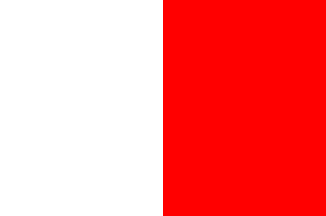![[Helmond new flag]](../images/n/nl-nb0hm.gif) by Jarig Bakker, 14 Apr 2004
by Jarig Bakker, 14 Apr 2004
adopted 3 Feb 2004; design: W.A. van Ham

Last modified: 2011-03-26 by andrew weeks
Keywords: helmond | helmet |
Links: FOTW homepage |
search |
disclaimer and copyright |
write us |
mirrors
![[Helmond new flag]](../images/n/nl-nb0hm.gif) by Jarig Bakker, 14 Apr 2004
by Jarig Bakker, 14 Apr 2004
adopted 3 Feb 2004; design: W.A. van Ham
The helmet is obviously originally chosen to make the arms canting,
even if it is not really in accordance with the origin of the name, if
I understand the text correctly.
Elias Granqvist, 14 Apr 2004
I guess that the helm(et) is canting for Helmond. The Grand Robert de
la Langue Française says that the French word "heaume" (used
only for medieval and heraldic helmets) was used in the Chanson de Roland
(1808) as "helme" or "healme", coming from the Frankish *helm, which
is probably also the root of the Anglo-Saxon words helm, helmet etc..
A small "heaume" was called a "heaumet" (rare), a "heaume"
was made in a "heaumerie" by a "haumier". The "heaumier"'s
beautiful wife was a "heaumière", one of them having been
celebrated by the poet Francois Villon in two poems called "Regrets"
and "Ballade de la Belle Heaumière".
In his series of epic poems called "La Legende des Siecles",
Victo Hugo gives in "Les chevaliers errants" a scaring description
of the knight-errants:
"Ils passaient effrayants, muets, masques de fer [...]
Leurs cimiers se dressaient difformes sur leurs heaumes [...]
"They went, scaring, silent, iron-masked [...]
Their crest stood on end, misshapen, over their helmet [...]"
Anyway, the Helmond helmet rather looks like a ice-hockey goal-keeper
facial protection, does not it?
Ivan Sache, 14 Apr 2004
 Shipmate Flagchart : http://www.flagchart.net
Shipmate Flagchart : http://www.flagchart.net
Sierksma's Nederlands Vlaggenboek, 1962 [sie62]
has:
Flagdescription: Two equally wide vertical stripes white and red.
This flag was adopted 2 Jun 1959. The colors are derived from the municipal
arms.
hm.jpg) image from this website.
image from this website.
The present municipal arms is: a helmet on which three oak-leaves and
a little bird.
The arms are evident and canting. It represents the rights and freedom
of Helmond. The first representation of a helmet on a seal dates from 1241,
without crest or shield. The helmet represents thee city of Helmond. Originally
the helmet was the medieval pot-helmet. Later the helmet was adapted to
contemporary tastes, and became a tournement-helmet. This is still to be
found on the municipal arms.
The oak-leaves represent Freedom. The birdy within the twigs is a medieval
ornament, without special meaning. The colors were first specified in the
16th century: argent over gules.
Jarig Bakker, 15 Apr 2004